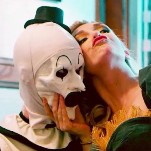Nothing's Fair In Fifth Grade: Pleading The Fifth
Welcome to ‘Fine Lines’, the Friday feature in which we give a far more wrinkled look at the children’s and YA books we loved in our youth. This week, Lizzie Skurnick rereads ‘Nothing’s Fair in Fifth Grade‘, Barthe DeClements 1981 classic about weight loss, multiplication and mean, mean mamas.
Nothing’s Fair in Fifth Grade is not Blubber. (No flensers, no French tutor.) It is also not Me and Fat Glenda. (Of this, I remember nothing except the cover of the sequel, Hey, Remember Fat Glenda? in which the now-slim heroine in question sports a beribboned sweetheart neckline on a flowered dress.) It’s also not The Cat Ate My Gymsuit (teddy bears, academic insurrection), nor whatever Sweet Valley High in which a character melts pounds off to reveal a face and bod that rival those of the Wakefield twins. (You tell me!)
But you could be forgiven for confusing Nothing’s Fair with the first two, because it hews to a similar storyline: a hefty new girl arrives in the classroom, is immediately and crashingly rejected by her new peers, fails to redeem herself through her likeable personality or other admirable traits, but finally manages to get ushered into the social circle through the narrator, a naturally skinny girl (peanut butter and cookies figure largely in her diet) who, after being forced into close contact with A FAT PERSON, realizes it’s not an actionable quality.
Jenifer (ah, remember that particular 80s-era spelling?) is skinny and secure-ish in a social pecking order that includes her bossy friend Diane, her snooty friend Sharon, and Jack, the brindle bulldo- I mean Jack, the cute redhead who hates his hair and therefore torments the girls mercilessly. When their new classmate, Elsie, arrives in the classroom, the students’ verdict is evenly divided between “Ugh,” “I hope she isn’t going to be in this room,” and “Gross.” (The author herself weighed in, entitling the chapter “The Fat Blond Girl.”)
And it only gets worse. Presaging her future role as diplomat, Jenifer observes, “I thought her mouth turned down sadly,” then moves onto the more pertinent, “I knew everyone hated having Elsie in our room.” Even that breath of empathy is short-lived: Elsie, on a strict diet, begs for other people’s desserts (an action for which she earns the nickname ‘scrounge’), gets 100% on tests (Jenifer is failing math), and finally is found to be the one swiping other students’ lunch quarters to spend on chocolate and licorice whips. (Jenifer, in fact, is the one catches her plunking down quarters at the corner store for the latter, then turns her in: “I knew,” she tells us, “I had looked into the eyes of a thief.”)
The classroom-based narrative is a distinct entity, one that endures because the classroom stands in for the larger social structure of childhood: a delicate petri dish in which authority rules with an unpredictable hand and the tiniest action can upset every other organism. Take Elsie’s fatness: as she stands before the class, her condition is less a trait than a probable contagion, the odiferous egg-salad sandwich in the unlucky individual’s lunchbag that taints the bearer beyond salvation. Winnowed down to such a narrow focus, each child’s brain is similarly without filters: the judgments that float through Jenny’s brain — say, that her friend Sharon is extremely piggy about gifts, or that Diane was plenty bossy before her father died — pass effortlessly through her consciousness, while our adult selves tamp down or seek to mitigate similar thinking, remembering on some atavistic level that such judgments could imprison you in the pecking order well into adolescence.
But why shouldn’t children judge? Because the other side of childhood Barthe DeClements depicts so unsparingly is how ruthlessly children are judged. In the world of Nothing’s Fair in Fifth Grade, your every action is brimming with consequence. Not only can spilling graham crackers on the floor get you smacked across the bottom with a broom (Don’t Hurt Elsie!), wanting to eat more than broth and carrots could get you kicked out of school. Eating too much at dinner and grossing out your father’s new girlfriend might make him never come around again — and don’t even get me started on what might happen if you hit someone with a baseball bat by mistake.
And it’s partly by observing the adult world come crashing down on any infraction of Elsie’s with the force of 10-thousand tons that activates Jenifer’s sense of injustice (hence the title), as the experience of injustice in her world had heretofore been limited to having to tolerate her little brother too often. And miraculously, it travels back up to the ruling parties. First, Jenifer’s mother takes the girls out to buy records when Elsie’s math tutoring brings up Jenifer’s grades. Next, Diane’s mother takes Elsie’s clothes from her at a sleepover and takes them in where Elsie’s pinned them. (After Elsie’s mother calls to scream that she can fix her own child’s clothes, in a particularly satisfying incident, Diane’s mother screams back, “Good! It’s about time you paid some attention to her!” and slams down the phone.) By the time Elsie manages to make two more major screwups, Jenifer has created a network that make sure Elsie’s “mean, mean mama,” in the words of Jenifer’s little brother, doesn’t send Elsie to boarding school.
There’s a sub-theme I hadn’t picked up on as a child: that when the girls make their grandest mistake — hitchhiking to a local shopping mall, with temporarily disastrous consquences — it’s because Jenifer’s mom has recently gotten a job and her generally amiable father, irritated at being un-manned by a working wife, has abandoned the children for his weekly bowling game. (I SWEAR this studiously offhand theme in these novels made me a raging feminist by age 10.) When the affair ends soundly, her father quips, “I guess your job isn’t worth all this trouble, eh?” and the Jenifer’s mother shoots back, “Or your bowling isn’t worth all this trouble.”
-

-

-

-

-

-

-

-

-

-

-

-

-

-

-

-

-

-

-

-

-

-

-

-

-

-

-

-

-

-

-

-

-

-

-

-

-

-

-

-








































